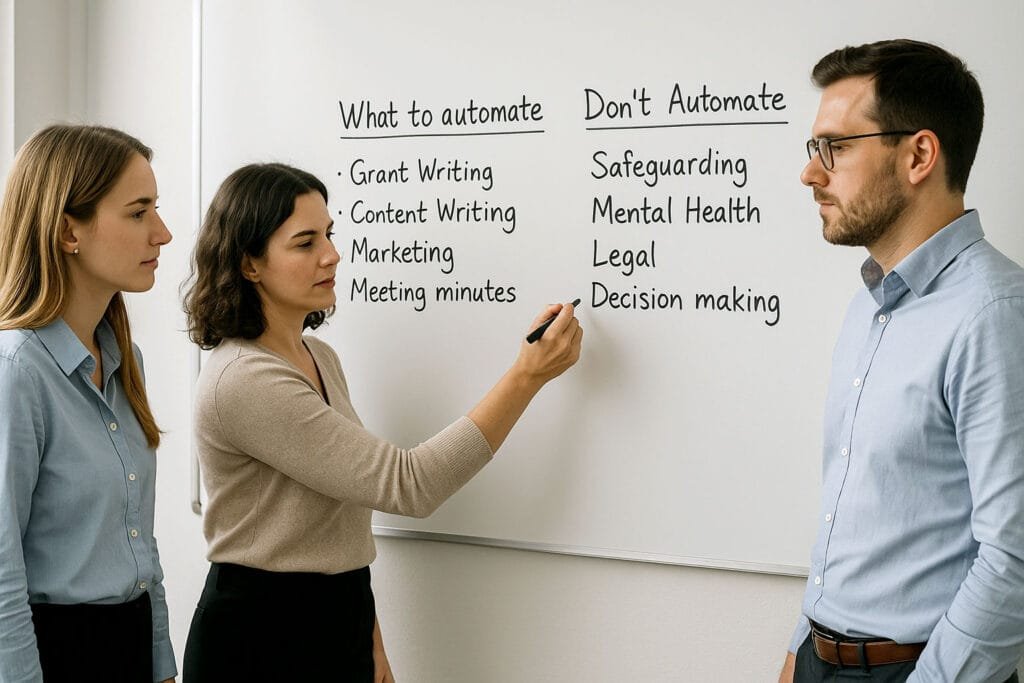TL;DR
- 76% of nonprofits lack an AI policy, yet smart automation can transform efficiency and fundraising results
- Start with low-risk tasks like grant writing and admin processes before moving to complex donor engagement systems
- Never automate sensitive support services, safeguarding decisions, or high-touch donor relationships where human empathy is essential
- Free tools like ChatGPT, Canva, and Google for Nonprofits offer powerful starting points without breaking charity budgets
Charities across the UK face an exciting crossroads. Technology promises to solve your capacity crisis, yet 70% of nonprofit professionals worry about data privacy and security when using AI. This tension creates uncertainty about where to start and what to avoid.
Smart charities are already seeing remarkable results. Organisations using AI for prospect research report 85% increases in appeal response rates and 20% increases in average gift size. But success comes from strategic choices about what deserves automation and what requires the irreplaceable human touch.
The secret lies in understanding that AI works best as your assistant, not your replacement. This guide cuts through the hype to show you practical applications that actually help, warn you away from risky automation, and provide a clear framework for making these critical decisions. You’ll learn which tools offer genuine value for charity work and how to implement them safely without losing what makes your organisation special.

What Can AI Actually Do for Your Charity Right Now?
AI transforms charity operations through three key areas: administrative efficiency, fundraising enhancement, and service delivery improvement. The best applications save time on repetitive tasks while freeing staff for mission-critical work.
Administrative Tasks That Benefit from Automation
Your charity likely spends countless hours on repetitive administrative work. AI excels at these routine tasks, creating immediate time savings. AI writing assistants can draft internal emails, summarise meeting minutes, and generate action lists, allowing your team to focus on strategic priorities.
Modern AI tools make document management effortless. You can automatically transcribe recordings, create structured reports from raw notes, and even generate policy templates.
Financial administration benefits enormously from AI assistance. Automated accounting software handles data entry, reconciliation, and report generation with impressive accuracy. Some charities report saving 200 hours of staff time monthly through intelligent financial automation.
Calendar management becomes seamless with AI scheduling assistants. These tools coordinate meetings across teams, send automated reminders, and even suggest optimal meeting times based on participant availability and workload patterns.
Grant Writing and Fundraising Support
Grant writing represents one of AI’s most valuable applications for charities. AI-powered grant writing tools trained on over 7,000 winning proposals help secure more funding by analysing requirements and generating targeted responses. These platforms understand funder preferences and suggest compelling language that resonates with decision-makers.
Research becomes dramatically faster with AI assistance. Tools can identify potential funders, analyse their giving patterns, and highlight alignment opportunities you might otherwise miss. Free ChatGPT tools specifically designed for charity fundraising help draft compelling applications even without fundraising experience.
Donor engagement transforms through intelligent segmentation. AI analyses supporter data to identify the best prospects for specific campaigns. Machine learning solutions recognise deep giving patterns, helping identify likely major donors and boost retention rates.
Communication personalisation reaches new levels of sophistication. AI drafts thank-you messages, creates targeted newsletters, and suggests optimal timing for different supporter segments. However, always review and personalise these outputs to maintain your charity’s authentic voice.
Content Creation and Marketing
Social media management becomes manageable even for small teams. Hootsuite’s OwlyWriter AI generates high-quality social media posts and suggests optimal posting times for maximum visibility. This ensures consistent online presence without overwhelming your communications team.
Visual content creation no longer requires design expertise. Canva for Nonprofits provides free access to AI-powered design tools, templates, and content suggestions for professional marketing materials. Create compelling infographics, social graphics, and campaign materials in minutes rather than hours.
Website content improves through AI editing and optimisation. Hemingway Editor uses AI to improve readability and grammar of written content, ensuring your message reaches supporters clearly and professionally.
Campaign brainstorming accelerates with AI creative assistance. Generate fresh fundraising ideas, develop compelling storylines, and create engaging content themes that resonate with your audience’s values and interests.

What You Should Never Automate (And Why)
Human judgment, empathy, and trust form the bedrock of charity work. Automating these functions risks undermining your mission and damaging stakeholder relationships beyond repair.
Safeguarding and Vulnerable People
Any interaction involving vulnerable individuals requires human oversight and empathy. AI cannot assess complex emotional states, recognise subtle signs of distress, or provide the nuanced support that safeguarding situations demand. The NSPCC actively works to understand AI risks for child safety, emphasising that sensitive protection work demands trained human experts.
Mental health support, crisis intervention, and abuse reporting must remain entirely within human control. Automated responses in these contexts risk causing harm, missing critical warning signs, or failing to provide appropriate escalation when needed.
Legal and compliance decisions involving beneficiary welfare cannot be delegated to algorithms. Your trustees retain ultimate responsibility for all organisational decisions, and this duty cannot be transferred to AI systems.
High-Stakes Relationship Management
Major donor relationships thrive on personal connection and shared values. Automating these interactions beyond simple administrative tasks would be counterproductive and potentially damaging. 63% of fundraisers feel unsure about using AI for donor communications because it seems less personal.
Board communications, trustee decisions, and strategic partnerships require human judgment and relationship-building skills. These relationships form the foundation of your charity’s sustainability and cannot be maintained through automated interactions.
Crisis communications demand authentic human responses. When your charity faces challenging situations or public scrutiny, stakeholders expect genuine, thoughtful communication that only humans can provide.
Mission-Critical Strategic Decisions
Financial planning, strategic direction, and resource allocation require human wisdom and ethical consideration. While AI can provide data and analysis, the final decisions must reflect your charity’s values and long-term vision.
Partnership agreements, merger discussions, and collaboration frameworks involve complex negotiations that require emotional intelligence and relationship skills beyond AI capabilities.
Service delivery strategies affecting beneficiary outcomes need human understanding of community needs, cultural sensitivities, and real-world implementation challenges that algorithms cannot fully grasp.

How to Decide What’s Worth Automating
Use a simple framework evaluating impact, risk, repetition, and human necessity. This systematic approach ensures AI enhances rather than undermines your charity’s effectiveness.
The Four-Factor Decision Matrix
Start by assessing each potential automation opportunity across four key dimensions. Impact measures how significantly the task affects your mission and operations. High-impact activities deserve careful consideration, while low-impact tasks offer safer experimentation opportunities.
Risk evaluation examines potential negative consequences. Consider data sensitivity, regulatory compliance, reputational impact, and stakeholder trust. 70% of nonprofit professionals worry about data privacy and security with AI, making this assessment crucial.
Repetition frequency indicates automation potential. Tasks performed weekly or daily with consistent steps make excellent candidates. Unique, one-off activities typically require human creativity and judgment.
Human necessity determines whether the task requires empathy, complex judgment, or relationship skills. Activities demanding emotional intelligence or cultural sensitivity should remain under human control.
Starting Small and Building Confidence
Begin with internal, low-risk applications before moving to public-facing automation. 69% of nonprofit professionals agree their job satisfaction would increase if AI tools reduced manual tasks. This creates positive momentum and builds organisational confidence.
Document management, meeting summaries, and basic content drafting offer excellent starting points. These applications provide immediate value while allowing your team to learn AI capabilities and limitations safely.
Test all outputs thoroughly before expanding the automation scope. Establish clear review processes and quality controls to catch errors before they affect stakeholders or beneficiaries.
Building Your AI Policy
Every charity needs written guidelines governing AI use. 76% of nonprofits lack an AI policy, creating unnecessary risk and confusion. Your policy should address data protection, accuracy verification, transparency requirements, and decision-making authority.
Include specific prohibitions around sensitive data input into public AI models. Staff must understand which information can never be processed through external AI systems, protecting donor, beneficiary, and organisational confidentiality.
Establish clear approval processes for new AI implementations. Designate who can authorise different types of automation and require impact assessments for significant changes.
Regular policy reviews ensure your guidelines remain current as AI technology rapidly advances. Schedule quarterly assessments to address new tools, emerging risks, and lessons learned from implementation experience.
Find out more about our AI Ethics and Governance services.

Free AI Tools Perfect for Charity Budgets
Numerous powerful AI tools offer free access specifically for nonprofits, making advanced automation accessible regardless of budget constraints.
Essential Free Platforms
Google for Nonprofits provides $10,000 in free Google Ads and AI-driven tools, offering substantial marketing power without cost. The programme includes Google Gemini, Google Sheets AI, and advanced analytics capabilities that typically cost hundreds monthly.
Microsoft Nonprofit Program provides access to AI-enhanced Microsoft 365 tools, including Copilot features for document creation, email management, and data analysis. This comprehensive suite handles most administrative AI needs through familiar interfaces.
ClickUp for Nonprofits offers AI-powered project management for free, streamlining volunteer coordination, task assignment, and progress tracking. The platform’s AI generates project summaries, suggests task priorities, and automates routine workflow management.
ChatGPT’s free tier provides powerful content creation and brainstorming capabilities. Momentum offers a free Major Gifts ChatGPT specifically trained on fundraising best practices, offering targeted advice for donor engagement without generic responses.
Design and Communication Tools
Canva for Nonprofits gives organisations free access to AI-powered design tools, eliminating design costs while maintaining professional visual standards. Create everything from social media graphics to annual report layouts using intelligent templates and automated design suggestions.
Grammarly AI helps nonprofits improve grant proposals, donor emails, and website content through AI-powered grammar, clarity, and tone suggestions. Professional communication becomes effortless regardless of writing experience or confidence levels.
Hootsuite features OwlyWriter AI, which generates captions and post ideas for comprehensive social media management. Schedule posts across platforms while maintaining consistent, engaging content that reflects your charity’s voice and mission.
Specialised Nonprofit Platforms
FreeWill’s Grant Assistant offers AI grant writing specifically trained on over 7,000 winning proposals, providing nonprofit-focused support for securing funding. The platform understands funder requirements and helps generate targeted responses that resonate with decision-makers.
Zeffy offers free AI-powered tools to find tailored fundraising ideas with personalised suggestions to match your goals and audience. The platform also surfaces grant opportunities that align with your organisation’s focus areas and eligibility criteria.
Free analytics tools help measure AI impact on your operations. Google Analytics provides website behaviour insights, while social media platforms offer engagement tracking to demonstrate AI-driven content performance and audience growth.
Remember that free tools often have usage limitations or require careful data handling. Always read terms of service regarding data use and retention, especially when processing sensitive donor or beneficiary information.
Getting Started: Your 90-Day Implementation Plan
Successful AI adoption requires structured planning, team preparation, and gradual implementation. This systematic approach minimises risk while maximising benefit.
Begin with a comprehensive readiness assessment covering organisational policies, technical infrastructure, and team capabilities. Identify current pain points where AI could provide immediate relief while noting areas requiring human oversight.
Week 1-2 focuses on team education and policy development. Research available tools, establish usage guidelines, and ensure all team members understand both opportunities and limitations. Create clear protocols for data handling and output verification.
Week 3-6 involves selecting and testing initial tools. Start with one or two low-risk applications like content drafting or meeting summaries. Document results, challenges, and lessons learned to inform future decisions.
Week 7-12 expands successful implementations while addressing any issues discovered during testing. Train additional team members, refine processes, and consider more advanced applications based on early experiences.
Monitor results continuously and adjust your approach based on practical experience. Track time savings, quality improvements, and any unexpected challenges to build evidence for future AI investments and strategic decisions.
The key to successful AI adoption lies in balancing enthusiasm with caution, ensuring technology serves your mission rather than driving it. Start small, learn constantly, and always prioritise the human connections that make your charity irreplaceable.




